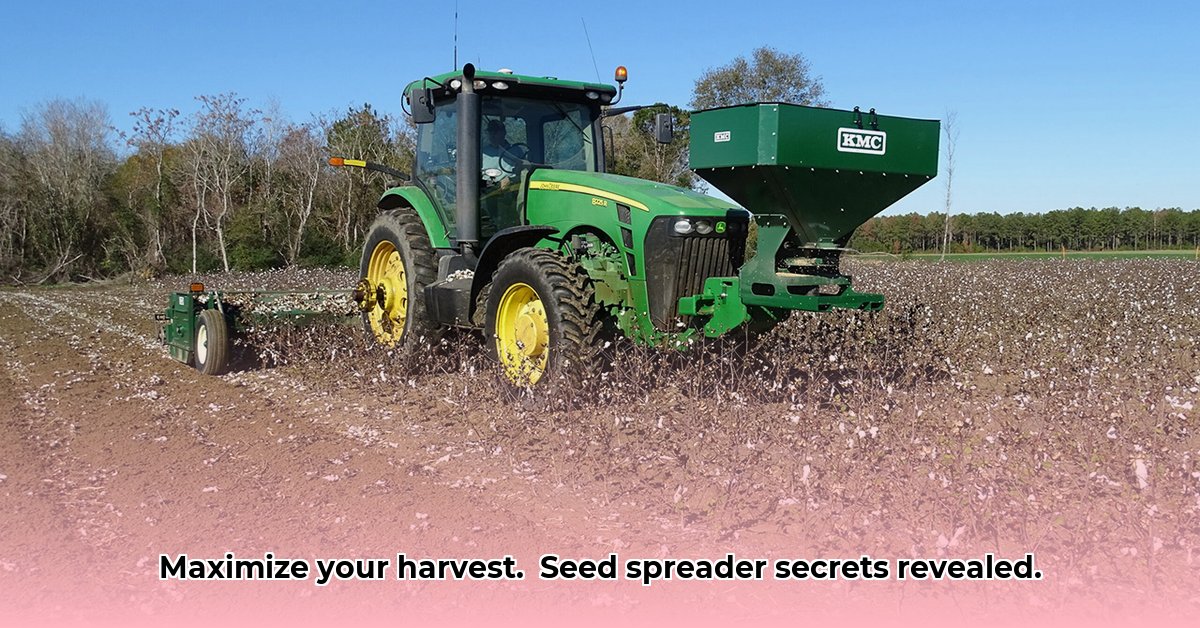
Planting efficiently is crucial for maximizing your harvest. A tow-behind seed spreader attached to your tractor offers a significant advantage in achieving this goal. This comprehensive guide covers everything from selecting the right spreader to its maintenance, ensuring you boost yields while minimizing environmental impact. Whether you're a seasoned farmer or just starting, this guide will empower you to plant smarter, not harder. For more options, check out this seed spreader guide.
Types of Tow-Behind Seed Spreaders
Choosing the right seed spreader depends on your specific needs. Consider capacity, seed type compatibility, and key features like metering mechanisms and planting depth adjustments. The wrong tool for the job can lead to wasted time and resources. Let's break down the options:
- Broadcast Spreaders: Ideal for smaller fields and cover crops, these spreaders distribute seeds over a wide area. However, precision is limited, resulting in uneven seeding density.
- Precision Drill Seeders: These offer the highest level of accuracy, ensuring consistent seed spacing and depth. They are best suited for larger fields where maximizing yield is paramount.
- Spinner Spreaders: Offering a balance between precision and capacity, spinner spreaders are versatile and suitable for a range of seed types and field sizes. They're a popular choice for their adaptability.
Here's a table summarizing the key differences:
| Seeder Type | Capacity | Seed Type | Metering Precision | Best Use Cases |
|---|---|---|---|---|
| Broadcast Spreader | Low to Medium | Small seeds (grasses, clover) | Low | Smaller fields, cover crops, quick seeding needs |
| Precision Drill Seeder | Medium to High | Various seed types | High | Large fields, precise planting, maximizing yield |
| Spinner Spreader | Medium to High | Smaller to medium-sized seeds | Medium | Versatile, good for various seeds, large fields |
Selecting Your Seed Spreader
Choosing the right seed spreader involves careful consideration of several factors. Making the wrong choice can significantly impact your planting efficiency and overall yield. This decision-making framework will guide you:
- Acreage: Larger farms require high-capacity seeders to minimize downtime. Smaller farms might find a smaller, more maneuverable model sufficient. How many acres do you need to cover?
- Seed Type: Different seeds require different spreaders. Are you planting small seeds like clover or larger seeds like corn or soybeans?
- Budget: Seed spreaders range in price, from a few hundred to thousands of dollars. Balance your desired features with your budget constraints. What's your realistic investment ceiling?
- Terrain: Uneven terrain necessitates a robust spreader capable of handling challenging conditions. What’s the topography of your fields?
Setting Up and Operating Your Seed Spreader
Correct setup and operation are critical for optimal performance. Following these steps will ensure you get the best possible results from your seed spreader:
- Calibration: Accurate calibration is paramount for even seed distribution. Improper calibration directly translates to uneven plant emergence and reduced yields. Carefully follow the manufacturer's instructions. Don't skip this step!
- Attachment: Securely attach the spreader to your tractor, ensuring stability and safety. A poorly attached spreader can be dangerous and ineffective.
- Seed Loading: Gently load the seed hopper, avoiding spills or damage to the seeds. Overfilling can lead to jams and malfunctions.
- Depth Adjustment: Adjust the planting depth based on your seed type and soil conditions. This significantly influences germination rates.
- Operation: Maintain a consistent speed during operation. Erratic driving can lead to uneven seeding patterns.
Maintenance and Troubleshooting
Regular maintenance is key for a long-lasting spreader. Ignoring maintenance leads to premature wear, costly repairs, and downtime.
- Cleaning: Clean your spreader after each use to prevent clogging and damage.
- Inspection: Regularly inspect for wear and tear. Address any issues promptly.
- Lubrication: Keep moving parts well-lubricated to ensure smooth operation.
Troubleshooting common problems is vital. Your owner's manual will be your first resource. If you encounter persistent issues, consult an agricultural equipment specialist.
Comparing Tow-Behind Seeders to Alternatives
Tow-behind seeders aren't the only option. Consider:
- Broadcast seeding: Simple and cost-effective but less precise.
- Aerial seeding: Suitable for large areas but expensive and weather-dependent.
The best method depends on your specific needs and resources. What's the most efficient approach given your circumstances?
Sustainability Considerations
Sustainable farming practices are essential. Your seed spreader plays a part:
- Minimize soil compaction: Use conservation tillage techniques.
- Maximize fuel efficiency: Choose a fuel-efficient spreader.
- Reduce seed waste: Accurate metering minimizes waste.
These practices benefit the environment and your bottom line. How can you further reduce your environmental impact?
Future Trends
Technology is transforming agriculture. Expect advancements like:
- GPS integration: Automated guidance for increased precision.
- Variable rate seeding: Adjusts seeding rates based on soil conditions.
- Sensor integration: Real-time monitoring for optimal performance.
Embracing these innovations will boost both efficiency and sustainability. What new technologies are you most excited about?
Conclusion
Investing in the right tractor seed spreader can significantly improve your farming efficiency and sustainability. By carefully considering the factors outlined in this guide, you can make an informed decision that boosts your yields and protects the environment. Remember, the right tools can pave the way for a successful harvest.